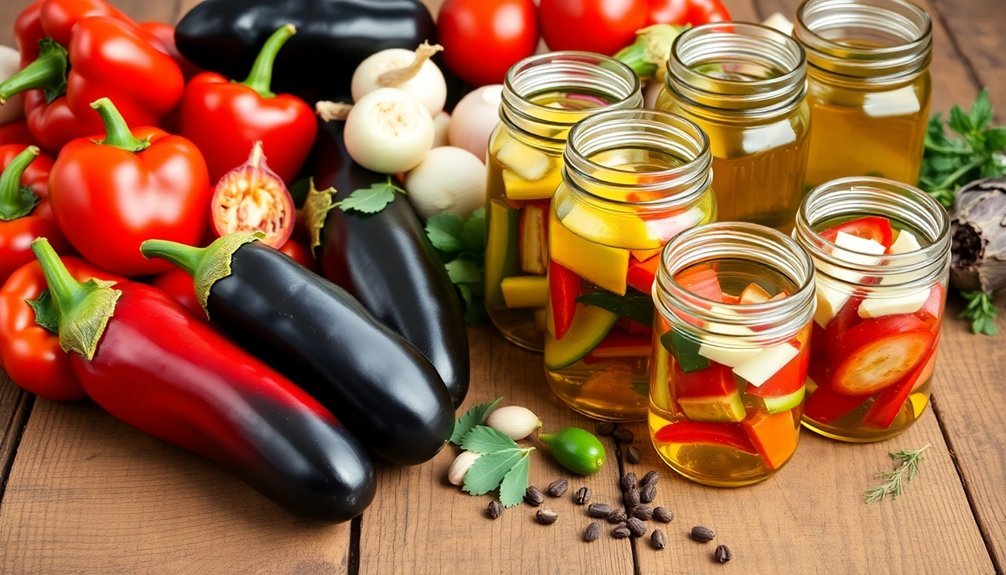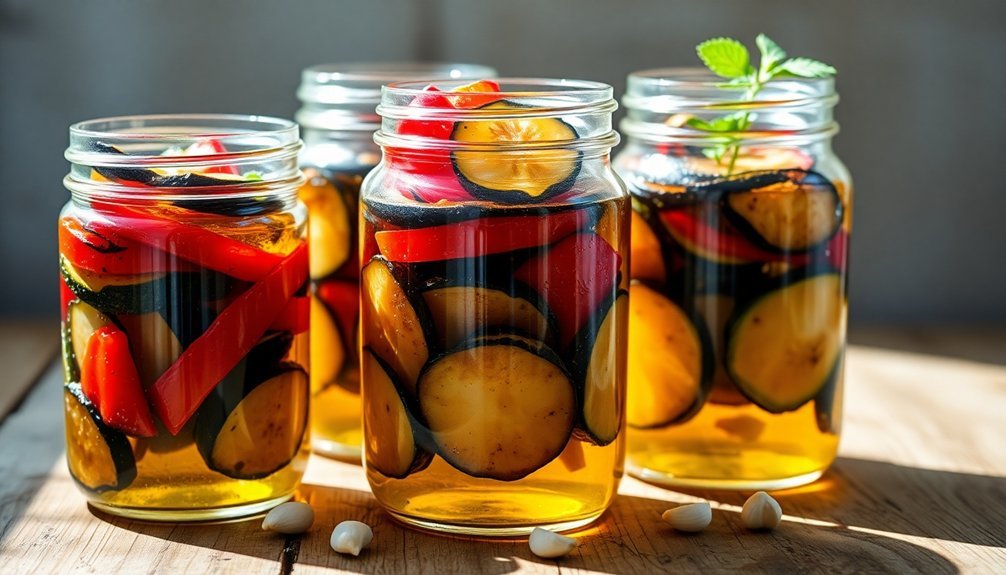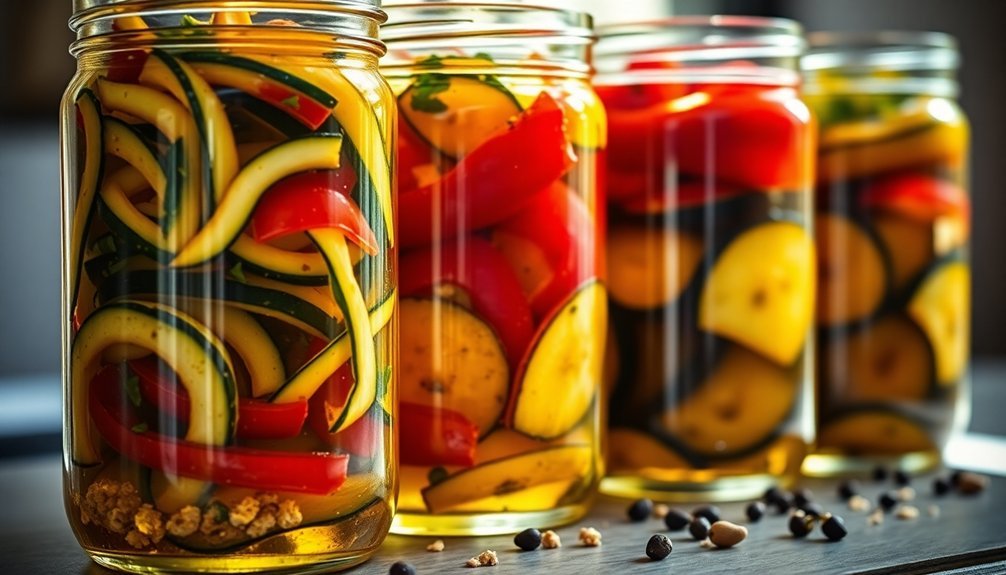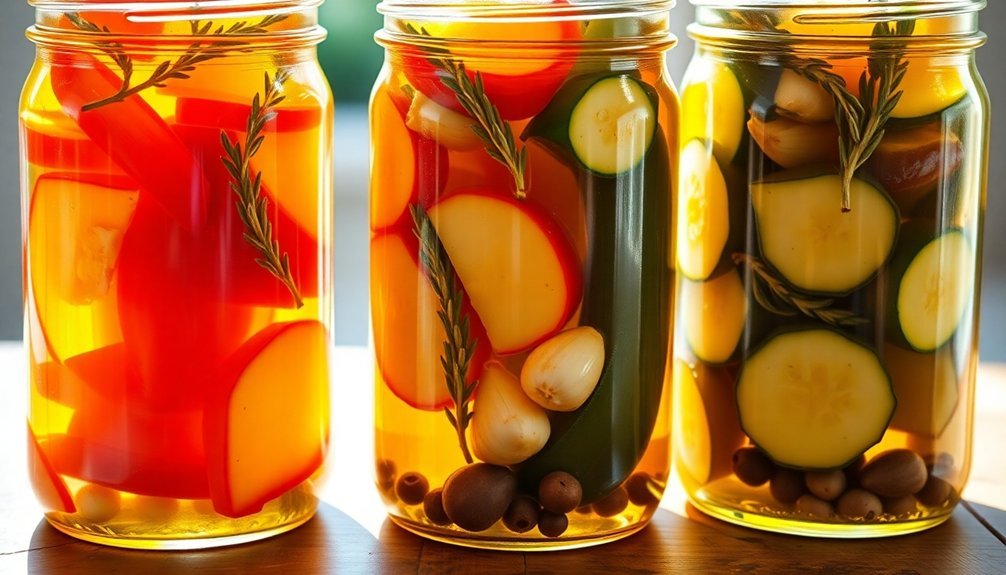To create oil-packed Mediterranean vegetables, you'll need to start with fresh, firm produce like zucchini, eggplant, and bell peppers cut into uniform ½-inch pieces. After washing and drying your vegetables thoroughly, roast them for 30-40 minutes until tender with slight charring. Once cooled, pack the vegetables into sterile glass jars and cover completely with a marinade of 2 parts olive oil to 1 part vinegar. Store your preserved vegetables in dark, cool places and refrigerate after opening – they'll last 1-2 months. These versatile preserves can transform your everyday cooking into something extraordinary, and there's so much more to discover about this time-honored technique.
Selecting Your Mediterranean Vegetables

Every great Mediterranean vegetable dish starts with selecting the right combination of fresh, colorful produce.
You'll want to focus on classic Mediterranean vegetables like zucchini, bell peppers, eggplant, summer squash, and tomatoes. Each vegetable should be cut to specific sizes – zucchini into slices or chunks, bell peppers into 1-inch pieces, and eggplant into 1×2-inch lengths. For best results, ensure vegetables are cut into uniform ½ inch pieces to promote even cooking.
To create visual appeal and balanced textures, combine vegetables of different colors and consistencies. Mix soft vegetables like zucchini and eggplant with crunchier options such as bell peppers. You can enhance your selection by adding red, orange, and yellow peppers, which provide both color variety and distinct flavors.
Don't forget to include aromatic additions like onions and fennel for depth.
While summer offers the best selection of fresh vegetables, you can find many options year-round at your local supermarket. Look for firm, unblemished produce with vibrant colors.
If you're growing your own vegetables, harvest them at peak ripeness. Cherry tomatoes should be firm but yielding, bell peppers should be crisp, and eggplants should feel heavy for their size.
Proper Preparation Before Preservation
Once you've selected your vegetables, proper preparation sets the foundation for successful oil preservation. You'll need to start by thoroughly washing your vegetables to remove any dirt or debris, then make certain they're completely dry to prevent unwanted moisture from compromising the preservation process. Best results are achieved when using only high-quality olive oil for preservation.
| Step | Action | Purpose |
|---|---|---|
| Clean | Wash & dry thoroughly | Remove contaminants |
| Trim | Cut away blemishes | Prevent spoilage |
| Cook | Roast, grill, or steam | Kill harmful bacteria |
Before cooking, remove any damaged parts and prepare your vegetables using clean, dry tools and containers. You'll want to cook them until they're tender, using stainless steel or non-reactive pans, especially if you're incorporating vinegar. During cooking, you can add your chosen flavorings like garlic, herbs, or spices.
For the marinade, combine olive oil and vinegar in a 2:1 ratio, making sure you've got enough to completely submerge your vegetables. The acid from the vinegar acts as a natural preservative, while the olive oil adds flavor and creates a protective barrier. You can enhance your marinade with additional ingredients like lemon zest, roasted garlic, or chile flakes for extra depth of flavor.
The Art of Roasting

Roast for 30-40 minutes, rotating the pan and stirring halfway through.
You'll know they're done when they're tender and slightly charred.
Place vegetables in a single layer on the baking sheet to prevent overcrowding.
Finish with fresh herbs and serve warm with lemon wedges.
Oil Preservation Fundamentals
Now that your vegetables are perfectly roasted, it's time to preserve their Mediterranean charm in oil. You'll need to create a marinade using 2 parts olive oil to 1 part vinegar, which helps maintain the acidity needed to prevent bacterial growth.
Pack your cooked vegetables into wide-mouthed glass jars, ensuring they're completely submerged in the oil-vinegar mixture. To maximize preservation, you'll want to minimize contact between your vegetables and both air and light. Use dark or opaque containers, and store them in a cool, dark place.
Make sure you're using clean, sterile glass jars rather than plastic ones, as oleic acid can react with most plastics. Keep the headspace in your containers to a minimum by transferring to smaller bottles if needed.
Don't skip refrigeration – it's essential for preventing unhealthy bacteria, especially when preserving with ingredients like garlic or herbs. While the oil may solidify in the fridge, that's actually a good sign. Just remove the jar 15 minutes before use to let it liquefy.
When properly stored, your oil-preserved vegetables can last up to 1-2 months, and they'll develop even better flavors after the first two weeks.
Creative Ways to Serve

After spending time preserving your Mediterranean vegetables, you'll find endless possibilities for serving these flavorful gems. From antipasti platters to pasta dishes, these versatile ingredients can transform everyday meals into Mediterranean feasts.
| Appetizers | Main Dishes | Accompaniments |
|---|---|---|
| Antipasti platters | Pasta with pesto | Salad toppings |
| Crostini toppings | Rice dishes | Sandwich fillings |
| Mezze components | Pasta salads | Side dishes |
| Charcuterie boards | Risottos | Grilled meat sides |
| Cheese platter elements | Quick suppers | Roasted vegetable garnish |
You'll find these oil-packed vegetables particularly versatile in soups and sauces. Try swirling them into your favorite soup for an extra punch of Mediterranean flavor, or incorporate them into homemade dressings and marinades. The flavored oil itself becomes a valuable ingredient, perfect for drizzling over roasted vegetables or using as a base for dips and spreads.
For quick meals, toss them with pasta, add them to grilled cheese sandwiches, or use them to elevate simple salads. They're equally at home in sophisticated risottos or casual bruschetta, making them an essential pantry staple for Mediterranean-inspired cooking.
Frequently Asked Questions
Can I Reuse the Infused Oil After Consuming All Vegetables?
You shouldn't reuse homemade infused oil after consuming the vegetables due to botulism risks. If you want to use it, do so within a month while keeping it refrigerated for safety.
What Signs Indicate the Preserved Vegetables Have Gone Bad?
You can't always rely on visual signs, as spoiled preserved vegetables may look normal. Watch for leaks, bubbles, foam, slime, unusual sediment, or separation. When in doubt, it's safest to throw them out.
How Long Should Vegetables Drain Before Packing in Oil?
You'll need to dry your vegetables for about 48 hours until they're barely damp and feel pliable. Make sure they're spread on clean kitchen towels and are leathery but not crispy before packing.
Why Do My Preserved Vegetables Float to the Top?
Your vegetables float because they've trapped air inside their structure. You're likely using raw-packing methods, not enough liquid, or overripe produce. Try hot-packing and ensuring proper liquid coverage to prevent floating.
Can I Mix Different Batches of Preserved Vegetables in One Jar?
You shouldn't mix different batches of preserved vegetables in one jar. It'll disrupt preservation times, compromise food safety, and affect flavor development. Always keep separate batches in their original containers for best results.
In Summary
You've now mastered the art of preserving Mediterranean vegetables in oil. With these techniques, you'll always have flavorful roasted peppers, eggplant, and zucchini ready to enhance your meals. Don't forget to store your preserved vegetables in a cool, dark place and use them within three months. They'll make perfect additions to antipasti platters, sandwiches, or pasta dishes whenever you need a taste of the Mediterranean.





Leave a Reply